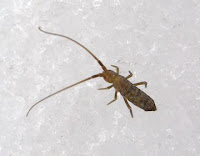I like this group of conifers, with a light dusting of snow making them look like Christmas trees.
 One of our favourite places to ski is this big open field. It has several hills to make the skiing more interesting.
One of our favourite places to ski is this big open field. It has several hills to make the skiing more interesting. Another group of conifers.
Another group of conifers. Yet more conifers, this time catching the evening sun.
Yet more conifers, this time catching the evening sun. On 6th December we had another snowfall, which added a further 8 cm to the depth. We were even able to ski along the main roads, and we didn't have to worry about the bus either, as it had been abandoned.
On 6th December we had another snowfall, which added a further 8 cm to the depth. We were even able to ski along the main roads, and we didn't have to worry about the bus either, as it had been abandoned. As the weather became colder again, hoar frost formed on exposed surfaces. Here it had formed large crystals along strands of sheep wool entangled in a barbed wire fence.
As the weather became colder again, hoar frost formed on exposed surfaces. Here it had formed large crystals along strands of sheep wool entangled in a barbed wire fence. Two nights after the coldest night, when the temperature outside dropped to -15°C, there was quick thaw. Our house also had a curtain of icicles round the edge of the roof and there were frequent crashes all evening as they fell off. After two particularly big crashes, I went outside to check and found a piece about the size and weight of a brick, so I thought I'd better not go outside any more. We had one icicle about 6 cm in diameter and several feet long, which was probably the other big crash as it was no longer there, but that one would have landed on the garage roof.
Two nights after the coldest night, when the temperature outside dropped to -15°C, there was quick thaw. Our house also had a curtain of icicles round the edge of the roof and there were frequent crashes all evening as they fell off. After two particularly big crashes, I went outside to check and found a piece about the size and weight of a brick, so I thought I'd better not go outside any more. We had one icicle about 6 cm in diameter and several feet long, which was probably the other big crash as it was no longer there, but that one would have landed on the garage roof.Below is a view to the Campsies taken in Milngavie.












































